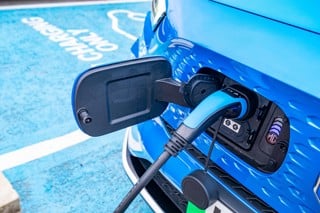Kevin Welstead, EV sector director at SSE Energy Solutions
According to a recent report from the Climate Change Committee, the current rise in electric vehicle (EV) adoption is outpacing UK Government growth projections.
While this fast-track transition to decarbonised transport is one we should readily celebrate, it’s clear that if we don’t accelerate infrastructure deployment in line with demand that growth will be hampered.
The current approach to accessible charging infrastructure across the UK is, at best, fragmented.
However, organisations that are willing to take a ‘big picture’ ambition to the issue will find a major opportunity to contribute to net zero goals and, in turn, grow their bottom line.
Making charging convenient, accessible and attractive to all - from fleet operators to commuters to those still yet to buy into EVs - will require participation from multiple stakeholders including local authority, energy, real estate and development groups.
This can only happen through a holistic, partnership-based approach that leverages both public and private investment.
How charging hubs work
That’s why community charging hubs represent an ideal blueprint for meeting local demand and evolving community needs.
From the design stage onwards, stakeholders can ensure that hubs provide flexible solutions, such as providing charging sessions to public and commercial fleets during the day while supporting community users in the evenings and weekends.
At SSE Energy Solutions, we have a roadmap to install 300 of these hubs across the UK over the next five years.
In September, we opened our first at Castlebank in Glasgow.
This site is strategically located to suit a variety of needs, from residents in the area that lack off-street charging, to fleet and commercial vehicles, as well as those visiting neighbouring amenities.
Rapid charging and convenient locations remove barriers to EV ownership by fitting into drivers’ lifestyles.
Key to our plan is forming partnerships with retailers, fleet owners and operators, as well as landowners and developers whose sites can unleash so much potential.
This includes our new partnership with pan-European real estate giants M7 that aims to deliver UK-wide infrastructure over the next 24 months that can dispense an estimated 2 million charges annually.
Fast, flexible and truly green
You can see why businesses such as M7 are keen to be involved.
Locating hubs at key locations like retail parks will appeal to the time-hungry motorist, whether private or commercial, and give people a chance to pick up groceries while their vehicle undergoes a rapid charge.
Hubs need to be near or on the routes that people use in their everyday life as well as along the routes used by fleets.
We are engaging with businesses and public bodies to identify further locations where there is demand and available land that can be developed.
In the longer term, it’s also important for hubs to include solar panels and battery storage to ensure a ready supply of electricity that doesn’t drain the local network.
The hubs we are developing will be genuinely sustainable as we can match the demand with output from our own renewables, such as wind farms, so users can be sure they are topping up with truly green electricity.
Opportunities to collaborate
The Climate Change Committee committee has urged "widespread deployment of charging infrastructure, ensuring that deployment rates accelerate in line with the trajectory required to deliver a minimum of 300,000 public charge points by 2030".
This underscores the need to invest, and for different parties to work together to hit those goals. It’s important to continue to break down the barriers to EV adoption.
The road to net zero is an exciting one, with huge opportunities for businesses to collaborate and support a successful transition.
> Interested in comparing electric vehicle data? Check out our EV tool.
> Interested in ensuring the efficient use of EVs. Check out our dedicated editorial sections: Insight & policy | EV news | Charging & infrastructure | Costs & incentives | Benefit-in-kind | EV case studies | EV road tests



















Login to comment
Comments
No comments have been made yet.